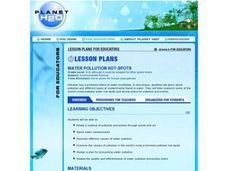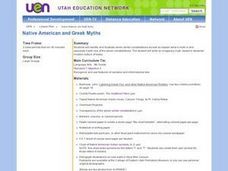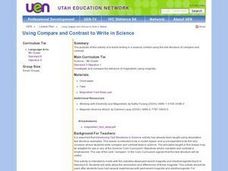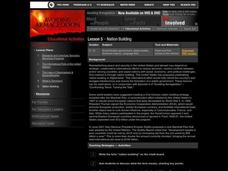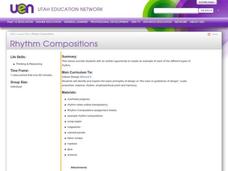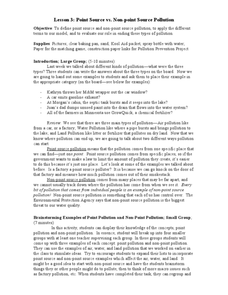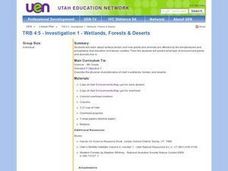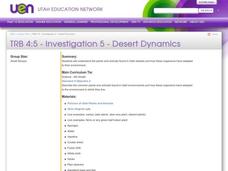Curated OER
Diseases
Sixth graders create a type of notebook or journal using colored copy paper on which to take notes. They complete research on a certain disease and report on it and then design their own disease causing bacteria or virus. Finally, 6th...
Curated OER
The Human Geonome Project Structured Controversy
Students debate government funding of the Human Genome Project. In this ethics lesson plan, students use the stuctured controversy framework to research the opposing viewpoints regarding project funding.
Curated OER
Angle Land and Angle Aerobics
Sixth graders investigate different types of angles. In this geometry instructional activity, 6th graders use a protractor to identify acute, obtuse, and straight angles.
Curated OER
Water Pollution Hot-Spots
Students complete internet research in small groups to identify types of water pollution, spotlight water pollution hot-spots, and design a plan for water prevention.
Curated OER
Voting and US Resident Aliens
Twelfth graders examine the process of voting. In this American Government lesson, 12th graders evaluate the arguments for and against alien voting. Students participate in a debate on voting rights.
Curated OER
Native American and Greek Myths
Fifth graders identify seven different constellations and explain a myth that accompanies it. As a class, they listen to myths associated with the Greek and Native American cultures. To end the activity, they write their own myth...
Curated OER
Naked to the Eye
Sixth graders conduct a variety of experiments that enable them to investigate bacteria. They use microscopes, prepared slides, video, moldy bread and pond water to observe types of bacteria and how bacteria interacts with the...
Curated OER
Using Compare and Contrast to Write in Science
Fifth graders investigate and compare the behavior of magnetism using magnets. In this physics lesson, 5th graders write about the similarities and differences of a variety of magnet types.
Curated OER
Nation Building
High schoolers explore the concept of nation building. In this diplomacy lesson plan, students research America's nation building efforts in Somalia, Haiti, the Balkans, Guatemala, Cuba, Vietnam, and Grenada. High schoolers share their...
Curated OER
Rhythm Compositions
Students investigate the concepts that focuses upon the musical rhythms. They conduct class discussion and use questions in order to clear up any misconceptions. Students create art compositions that illustrate rhythm and then each one...
Curated OER
Foundation, Nonprofit, All Matter to Me
Students examine different types of foundations and non-for-profit organizations. They identify the focus of the different organizations. They finally relate the beginning of certain foundations or non-for-profit organizations with...
Curated OER
Point Source vs. Non-point Source Pollution
Young scholars define and differentiate between point source and non-point source pollution. Students discuss various types of pollution including air, water and land pollution, analyze demonstrations and complete a worksheet.
Curated OER
Food Poisoning
Students study the bacteria that cause food poisoning using a written resource. They complete a research worksheet entitled, "America's Most Wanted." Next, they create a short skit about the causes, symptoms, prevention, and other...
Curated OER
Analysing 2001 Census Microdata
Eighth graders examine the census data of 2001. In this American History lesson, 8th graders analyze data using one- and two-variable statistical analysis. Students develop a research question that makes use of the microdata.
Curated OER
Exploring Our Community
Students identify nonprofit and profit organizations in their community. They discuss why it is important to have both types of organizations. They create a land use map of their community.
Curated OER
Local Environmental Issues: Pollution
Third graders discuss the ways in which human interaction with the environment and production of waste products contribute to pollution. Through a pollution demonstration, they explain how various groups of plants and animals can be...
Curated OER
Trade in the Global Village
Young scholars use the internet to research the trade status and needs of a country of their choice. Using this information, they determine which three main products their nation needs to import and which ones they can export. They...
Curated OER
Mapping the changes in Canada's population
High schoolers find and analyze data found in the census. They compare the population from 1996 to 2001. They explore the type of data they can find in the Census of Population.
Curated OER
Representing Our Nation
Students use pennies to illustrate how our states are represented in Congress. This instructional activity is to be implemented during a unit covering the branches of United States government.
Curated OER
A Date Which Will Live in Infamy
High schoolers analyze Franklin D. Roosevelt's "Day of Infamy" War Address. Students read the original first typed draft of the speech, and compare handwritten changes with the original to determine whether the changes strengthened or...
Curated OER
Wallpaper Pattern
Students identify, explain and use the basic elements of design. They find examples of the four different types of patterns by using wallpaper as their medium. They identify the four different types of pattern and find correct...
Curated OER
Investigation 1 - Wetlands, Forests & Deserts
Fourth graders examine surface terrain and how plants and animals are affected by the temperatures and precipitation that elevation and terrain creates. Then students predict what type of environment plants and animals live in.
Curated OER
Comparing Apples and Oranges
Fifth graders, in groups, examine different types of apples and how they are different. They also taste the differences of each apple. They use this lesson to explore how to make observations.
Curated OER
Desert Dynamics
Fourth graders examine the various types of plants and animals found in the deserts of Utah. In groups, they discover how the plants and animals have adapted to the harsh environment. To end the lesson, they compare and contrast the...





